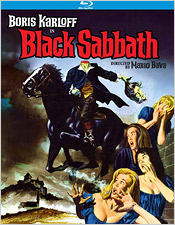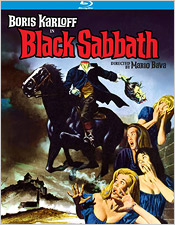Black Sabbath: AIP Version (Blu-ray Review)

Director
Mario BavaRelease Date(s)
1963 (July 21, 2015)Studio(s)
A.I.P./Orion Pictures/MGM/20th Century Fox (Kino Lorber Studio Classics)- Film/Program Grade: B
- Video Grade: A-
- Audio Grade: A-
- Extras Grade: D+
Review
Mario Bava’s Black Sabbath from 1963 may not have been the first (at least what became traditionally known as) anthology horror film, but it’s certainly one the more famous ones. It may not have been much of a pioneer, but it was perhaps more of an innovator. Its style and execution paved the way for the many that followed, in particular those produced by Hammer Productions and Amicus Productions, and helped to establish Mario Bava as one of horror’s most distinguished directors.
Black Sabbath tells three tales, all introduced by Boris Karloff himself. In the first (The Drop of Water), a nurse is called to aid a caretaker in preparing the corpse of a rich gypsy woman before her funeral. The nurse’s greed gets the best of her when she steals a beautiful ring off of the corpse and is consequently haunted by the gypsy’s apparition. The second tale (The Telephone) follows a woman who is receiving mysterious and threatening calls from a stranger which increase in intensity until the heart-stopping conclusion. The third (The Wurdalak) tells the story of a nineteenth century family haunted by their father, a member of the undead who seeks to turn all of his family members into vampires.
Although it was successful, Black Sabbath originally appeared in the U.S. in a much different form. It’s a different kind of beast compared to the European version. Prior to American International Pictures releasing the film in the U.S., a large number of changes were made to the film. Seeking more of a Friday night crowd of teenagers and less of a sophisticated audience, A.I.P. trimmed various moments of violence and re-shot all of Boris Karloff’s introductions to each segment, even inserting new footage. Other changes included rearranging the order of the three stories, recording a new dubbing for English language audiences, and inserting a new score by Les Baxter. The order of the three stories in the original Italian version of the film were The Telephone, The Wurdalak, and The Drop of Water, with the score being composed by Roberto Nicolosi. The biggest change in terms of visuals, however, was a completely different look to the film. Color and contrast deviated from the original version during many scenes.
With all of these changes made, the overall experience is, indeed, entirely different. First and foremost, the most effective segment is The Drop of Water, and it definitely belongs at the end of the film. From a filmmaking perspective, you very much want the audience walking out with a strong visual in mind to help make it memorable, and the haunted corpse from that segment definitely fulfills that notion. The Telephone segment also feels like an opening, and a bit of a giallo as well. It’s the kind of story that should work to get you intrigued in the film and make you stick around to see the rest of it. Arguably the least interesting story is The Wurdalak, despite the presence of Karloff as a leading character, and it appropriately belongs in the middle.
It’s obvious by now that I feel that the Italian version is a much more effective film than its U.S. counterpart. The U.S. version feels like it’s missing some teeth and some grittiness, and plays more like a Roger Corman film than a Mario Bava film. That’s not an insult, by the way. They are just different flavors, both good, but when mixed together, they don’t produce the same kind of results. Still, Black Sabbath is a film that’s worth seeing, regardless of which version you prefer. Many viewers stateside have only ever seen the U.S. version anyway, so it’s all a matter of preference.
As the film was released by Arrow Video a couple of years ago on Blu-ray and contained both versions of the film with a substantial amount of extras, I feel I must compare the Kino Lorber U.S. Blu-ray release to it. It’s also worth noting that Kino Lorber also released the Italian version separately on disc, as well. On the whole, image quality is much of the same on both the Kino and Arrow releases, which is great. Although both versions of the film feature different color palettes and contrast levels in key scenes, the A.I.P. version still has a strong, organic look to it. Grain levels are handled quite well. Colors are very strong but not totally accurate (the same goes for skin tones). Black levels are mostly deep, and both contrast and brightness levels are appropriate. The film shows its age from time to time, mostly during transitions, but there are very few film artifacts left behind. There are also no signs of excessive D.N.R. or other unwanted anomalies. The lossless soundtrack is an English mono DTS-HD track. It’s a very good track with dialogue front and center with the score and sound effects having a nice round feeling to them. And while not overwhelming, background hiss creeps in from time to time. It’s not burdensome, per se, but it does stand out when it appears. Unfortunately, there are no subtitles to choose from, which I find a little odd.
Also disheartening is the extras selection. The one saving grace is a brand new audio commentary from Mario Bava biographer and film critic Tim Lucas. There’s also the film’s original theatrical trailer, as well as a trailer for another Kino Lorber Studio Classics title The Crimson Cult. Comparatively, Arrow Video’s Region B Blu-ray release trumps Kino’s in nearly every category, especially in the extras. That release also contains, as previously mentioned, the Italian language version of the film I Tre Volti Della Paura, but also subtitles on both versions. It also features an older audio commentary by Tim Lucas; the Twice the Fear comparison featurette; an introduction to the film by author and critic Alan Jones; A Life in Film, an interview with actor Mark Damon; the film’s international, U.S., and Italian trailers; a set of TV and radio spots; and an insert booklet with an essay on the film by critic David Cairns, an interview with A.I.P. producer Samuel Z. Arkoff conducted by Tim Lucas, and a set of various production stills and posters. Also missing from previous U.S. DVD releases are various image galleries.
When it comes to which version of Black Sabbath I would recommend, I have to go with the Italian version as I find it a more complete and more compelling film. As for which home video release of the film I would recommend, it all depends on your relationship with the film and how accessible Region B releases are for you. If you’re a die-hard fan of the film and have the ability to play it on your machine, the Arrow Video release is the best home video release currently available. However, if you simply want to watch the film (as well as its Italian counterpart), you can’t really go wrong with these Kino Lorber releases.
- Tim Salmons

